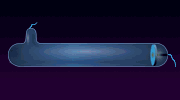|
 |
| With a current passing the
tube, a changing pattern of colorful lights
emerges as it is evacuated. Research with the
tube gave evidence that rays of some kind are
traversing the tube. Thomson concluded that
irrespective of the type of material at the
cathode where the rays start the rays were the
same. |
|
|
|
The cathode rays are deflected
by electric or magnetic fields, which show that they
are electrically charged. By adjusting the relative
strengths of the electric and magnetic forces
surrounding a tube through which the rays were
passing, Thomson was able to work out the mass per
unit of charge of whatever particles the rays
consisted of. He found that these entities were some
2000 times lighter than the lightest known atom,
hydrogen. Moreover, the results were the same,
independent of what metal the cathode in his tune
consisted of, or what gas had been in the tube. He
made the inspired guess that these "electrons" are
constituents of hydrogen, and indeed of all
elements.
When cathode rays in a vacuum
are focused onto hard targets they can produce
X-rays. Philipp E. A. von Lenard showed that cathode
rays pass through thin leaves of metal, and thereby
invented a cathode ray tube with a thin aluminum
window through which the rays could pass into the
open air.
|